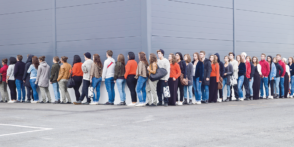Data Points to Needed Diversity Focus
Experts weigh in on how diversity in the transportation workforce, equity in designs and inclusion in programs could have major positive safety impacts
New Designs for Equity
Leah Shahum, Executive Director, Vision Zero Network
Every day in the United States, an average of 117 people die in traffic crashes. This added up to an estimated 42,060 lives tragically cut short in 2020, and millions more injured.
These figures are startling, to be sure. And the situation grows even more grim when we learn that some people are at far greater risk of being injured or killed in traffic crashes than others. For instance, traffic crashes are the leading cause of death among America’s youth. Our seniors are also at greater risk. Traffic deaths among people walking and bicycling are also growing, and the rate of these tragedies far outpaces people in cars.
Perhaps least discussed is the fact that people of color and low-income people in the U.S. are disproportionately hit and killed in traffic crashes while walking. According to Smart Growth America’s Dangerous by Design report, between 2010 and 2019, Black people were struck and killed by drivers at a rate 82% higher than white, non-Hispanic Americans. For American Indian and Alaska Native people, that disparity climbs to 221%. And according to the same analysis, the fatality rate in the lowest-income neighborhoods was nearly twice that of middle-income census tracts (in median household income) and almost three times that of higher-income neighborhoods.
But it does not have to be this way. As a deeper dive into the data shows, we get what we design for. Across the nation, there has been far greater investment of safety resources in some areas than others. For instance, in communities of color and low-income neighborhoods, there are more big roads carrying more high-speed traffic and more freeway touchdowns; at the same time, these neighborhoods are less likely to have complete, connected networks of sidewalks and bikeways.
At the nonprofit Vision Zero Network, we are working with communities across the nation to set and advance the goal of zero traffic injuries or severe injuries among all road users. To make progress, we must put more resources toward the safety of those who have been underserved for too long.
While educating people to “do the right thing” to be safe on the streets is important, individual actions only go so far when the underlying systems we’ve created do not prioritize safety. We need to move past blaming individuals and focus on improving the barriers to safety by redesigning roadways, reducing speeds and ensuring vehicles are designed for safety first.
We can make real strides toward Vision Zero—safe mobility for all— but it will take real leadership to change the systems we move in to prioritize safety over speed.
Diversity in All Directions
Neil J. Pedersen, Executive Director, Transportation Research Board
The Transportation Research Board is a part of the National Academy of Sciences, Engineering and Medicine. We discuss all aspects of transportation issues—current and future. In the last year and a half, there has been much more discussion about the inequitable impacts of past decisions and how we must find ways to mitigate them and ensure future decisions account for equity.
One way to account for equity is diversifying the transportation workforce; we need to make sure that our recruitment efforts reach diverse candidates who can compete for the positions. Diversity must also be considered during the selection process. Programs to sponsor under-represented minority students can help engage them in transportation activities and increase interest in the area, and fostering curiosity in STEMM (Science, Technology, Engineering, Medicine and Math) at young ages can help promote workforce diversity. We also need to recognize that diversity is more than gender, race or ethnicity—we need to have diverse teams regarding expertise and educational backgrounds, as well. Transportation at the professional level tends to be dominated by engineers, but transportation is really a part of the broader society, so we need experts with different backgrounds.
We are seeing a shift in project development where we are now trying to involve communities from the beginning to plan objectives. Often, these communities have more diverse populations. Having more diverse teams in development brings different perspectives. I’m convinced this gives us better products and services.
As we develop plans and select projects to be funded, we need to take equity into account. It goes back to planning. Equity needs to be a central goal and factor, and since it has received far more focus recently, there is a greater desire from leaders wanting to learn and understand. It needs to be recognized that it is a critical part of the decision-making process.
I’ve been in this field for 40 years. We’ve had a lot of challenges around diversity, equity and inclusion, but I am very hopeful—due to what I’m seeing at all levels of government—that these issues are receiving the serious attention they deserve.
Traffic Stops Need to Focus on Safety
Jonathan Adkins, Executive Director, Governors Highway Safety Association
What are the reasons for traffic stops? This is one of the basic questions we need to ask when addressing racial disparities in traffic stops and enforcement.
While enforcing traffic safety laws is only a small part of what police do every day, traffic stops are the most common way the public interacts with law enforcement, so we want to do everything that we can to make sure that the stops are only based on safety issues. The most critical thing we can do is promote transparency, so the public starts to trust law enforcement and understand that enforcement officers are out there for their benefit.
From the Governors Highway Safety Association’s (GHSA’s) standpoint, stops need to be about safety, and they need to be about significant safety issues, such as drunk driving, seat belt use and speeding. Those are the things that are killing motorists. We think there needs to be a national conversation about other stops, such as expired license plates. We want to focus on traffic safety stops and not just traffic stops.
To understand the disparity issue, we have to look at the data. We’ve known there is a problem but needed to be able to pinpoint it, so GHSA did a data analysis report, which came out in June. This showed that BIPOC (Black, Indigenous and People of Color) are disproportionally impacted in traffic deaths. While we have this initial data, we need more information about who is getting stopped and why. We need this data to fully understand the disparities and look at how we can minimize the need for traffic stops. This would eliminate the potential for problems. One way to do this is through automated enforcement—cameras don’t see race or gender.
People working in transportation also need to be diverse; they need to look like the communities they serve. Transportation has been far too white and male for far too long. We need to change how and where we recruit. There is an opportunity now with hybrid working, because people don’t have to live in the area where their job is located. This opens a wider applicant pool. We need people of different races, sexual orientations and genders out front as part of organizations’ leadership, so people of our communities can say: “I can see myself working there.”
If we engage more people, we will be more successful at keeping people safe. People will feel ownership of these programs and see the benefits they provide. We will have a better sense of what’s going on in every community. We will have more diversity in leadership and program administration, which can lead to fewer traffic stops and help everyone move about their communities safely.




